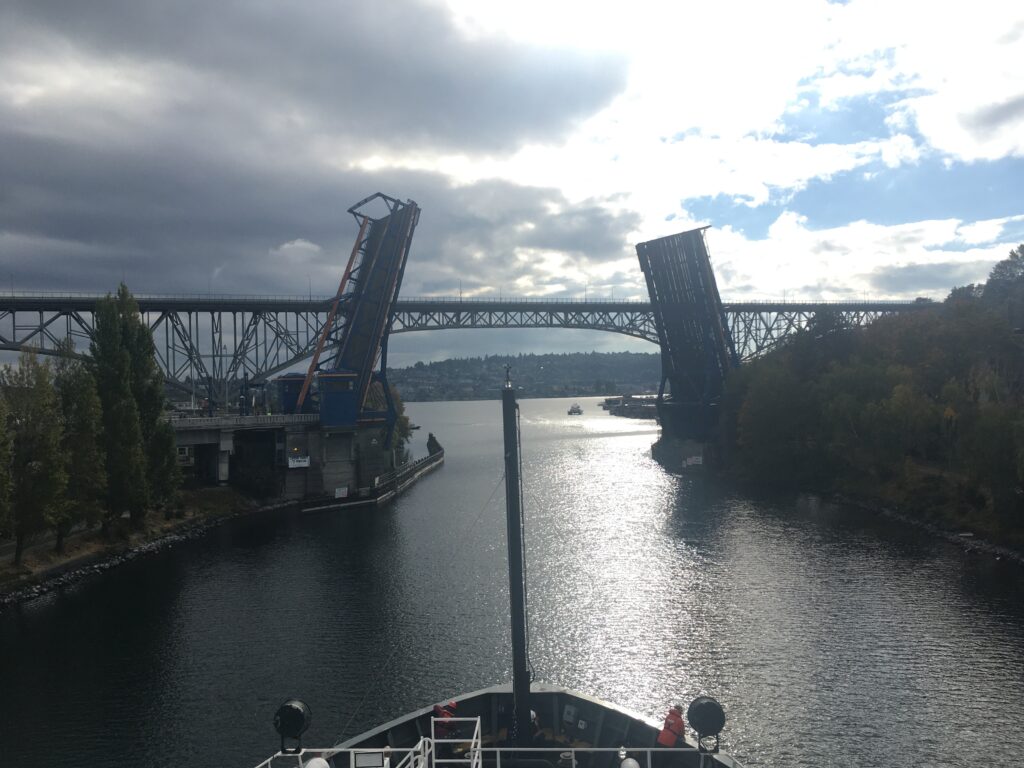By Rachel Kaplan, PhD student, OSU College of Earth, Ocean and Atmospheric Sciences and Department of Fisheries, Wildlife, & Conservation Sciences, Geospatial Ecology of Marine Megafauna Lab
By Renee Albertson, Senior Instructor and Research Associate, OSU Department of Fisheries, Wildlife, & Conservation Sciences, Marine Mammal Institute
Going to sea is always full of surprises, and the most recent Northern California Current (NCC) cruise was no different. We had surprises both logistical and scientific, disappointing and delightful. By the end, what stood out clearly is that with a great team of people like the one aboard the R/V Bell M. Shimada, any challenging situation is made the best of, and any exciting moment is only more so.
A few days into the cruise, engine trouble caused the Commanding Officer to decide that we needed to cut the trip short, halt instrument deployment operations, and head in to port. Lucky for us, this new plan included 30 hours of transit to Seattle, and long transits are exactly when we collect marine mammal observations. We were able to keep surveying as we moved up the coast and through the Strait of Juan de Fuca into Seattle. There were many surprises here too – we did not find whales in areas where we have previously sighted many, and overall made fewer sightings than is typical.
For example, we expected to see many whales on the Heceta Head Line (south of Newport), whose shallow depth makes the region a rich underwater garden that supports prey and attracts whales. Instead, we saw hardly any whales in this area. Perhaps they simply weren’t present, or perhaps we missed spotting some whales due to the heavy fog, which makes sighting animals that are not near the ship difficult to impossible. This dearth of animals led us to have to interesting conversations with other researchers as we speculated about what might be going on. The scientists on board these NCC cruises collectively research a wide range of oceanographic fields, including ocean chemistry, phytoplankton, zooplankton, fish, seabirds, and marine mammals. Bringing these data together can provide a better understanding of how the ecosystem is changing over time and help contextualize observations in the moment.
Though we often think about how the distributions of prey structure those of foraging whales, we started to wonder whether a lower trophic level could be at play here. Interestingly, in situ phytoplankton analyses showed a type of diatom called Pseudo-nitzchia along much of our cruise track, with the highest concentration off Cape Meares. In stressful conditions, these diatoms sometimes produce the toxin domoic acid, and we wondered whether this could possibly be related to the low whale counts.

Along the northern Oregon coast and near the Columbia River, the number of whales we observed increased dramatically. The vast majority were humpbacks, some of which were quite active, breaching and tail slapping the surface of the water. On our best day, we turned into the Strait of Juan de Fuca and sighted about 20 whales in quick succession, as well as a sea otter, and both Steller and California sea lions.
Simultaneously as we surveyed for whales, we were able to continue collecting concurrent echosounder data, which reveals the presence of nearby prey like krill and forage fish. Early in the trip, other researchers also collected krill samples that we could bring back to shore and analyze for their caloric content. Even with a shorter time at sea, we felt lucky to be able to fulfill these scientific goals.
Research cruises always center around two things: science and people. Discussing the scientific surprises we observed with other researchers aboard was inspirational, and left us with interesting questions to pursue. Navigating changes to the cruise plan highlighted the importance of the people aboard even more. Everyone worked together to refine our plans with cooperation and positivity, and we all marveled at what a great group it was, often saying, “Good thing we like each other!”

On the last day of the cruise, we transited into Seattle, moving through the Ballard Locks and into Lake Union. It was an incredible experience to see the city from the water, and an amazing way to cap off the trip. With the next NCC cruise ahead in a few months, we are excited to get back out to sea together soon and tackle whatever surprises come our way.
Did you enjoy this blog? Want to learn more about marine life, research, and conservation? Subscribe to our blog and get a weekly message when we post a new blog. Just add your name and email into the subscribe box below.


